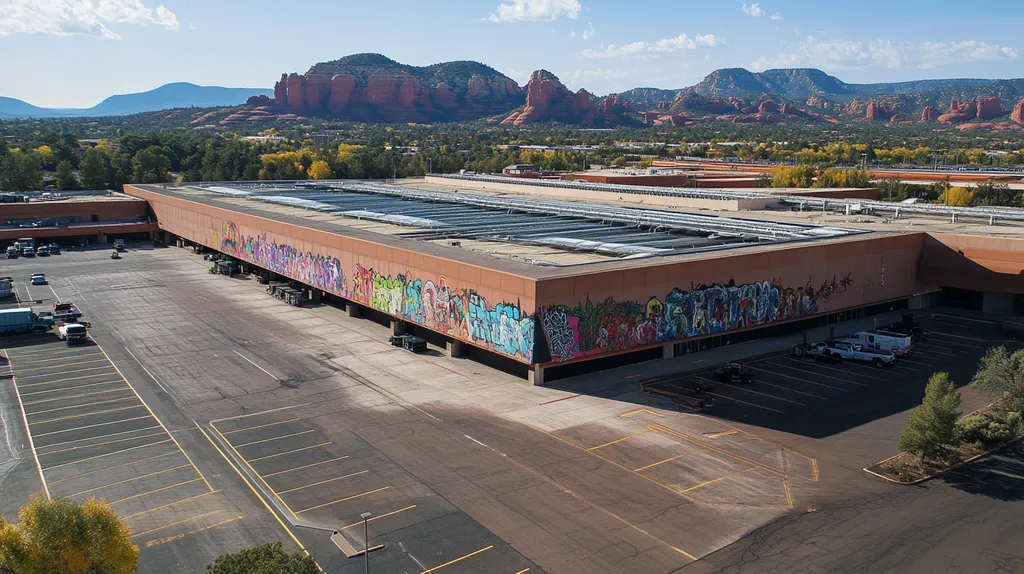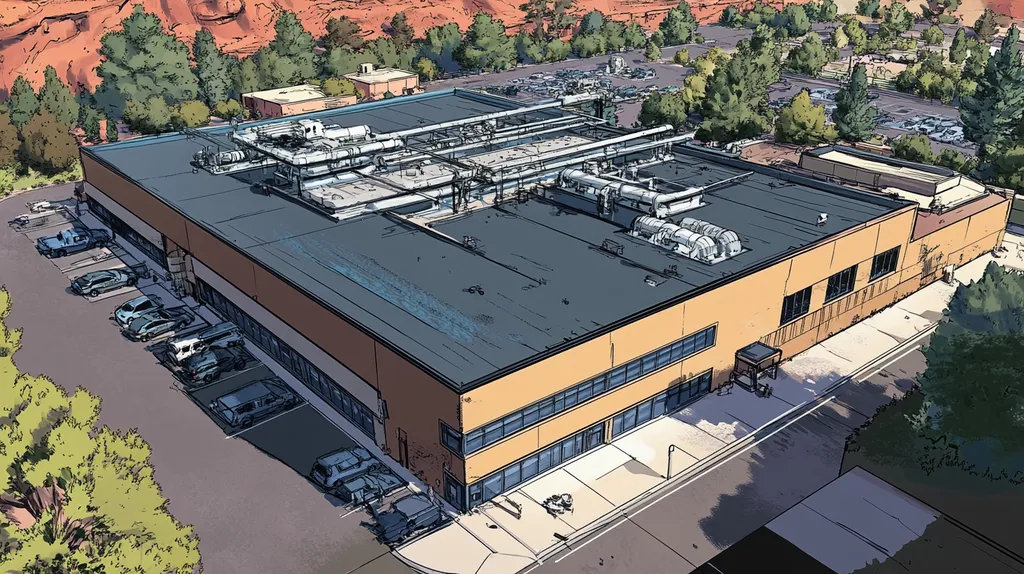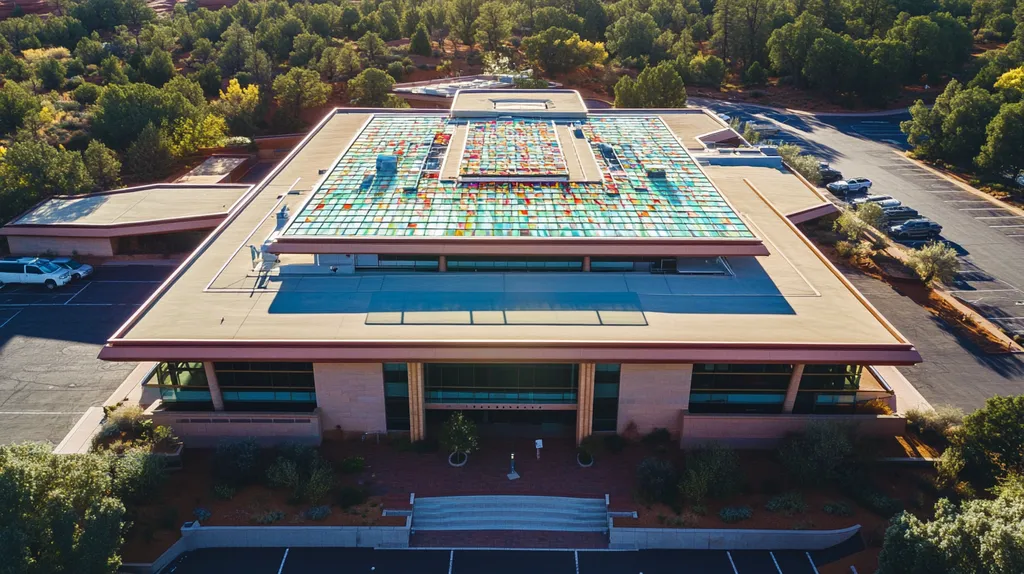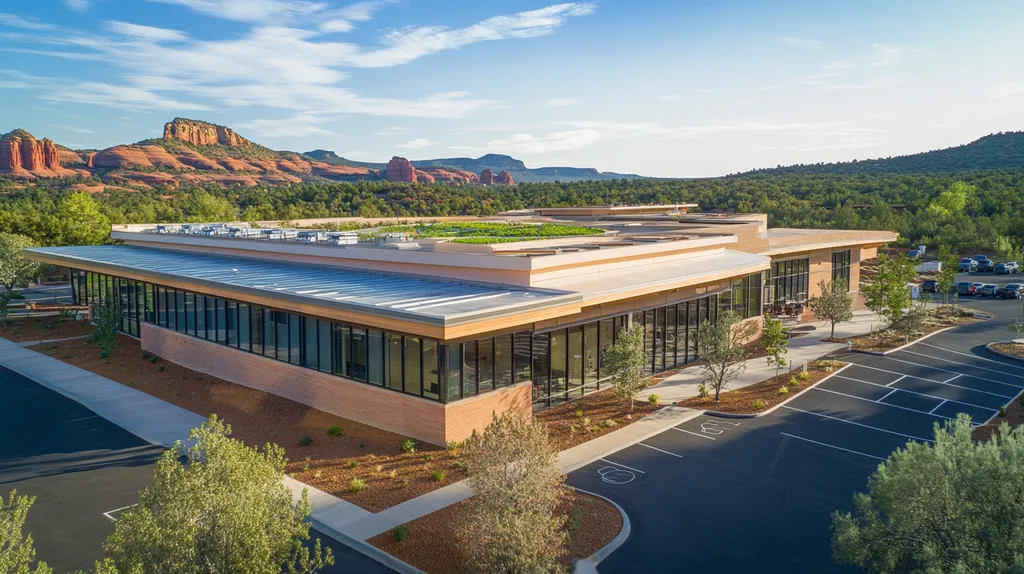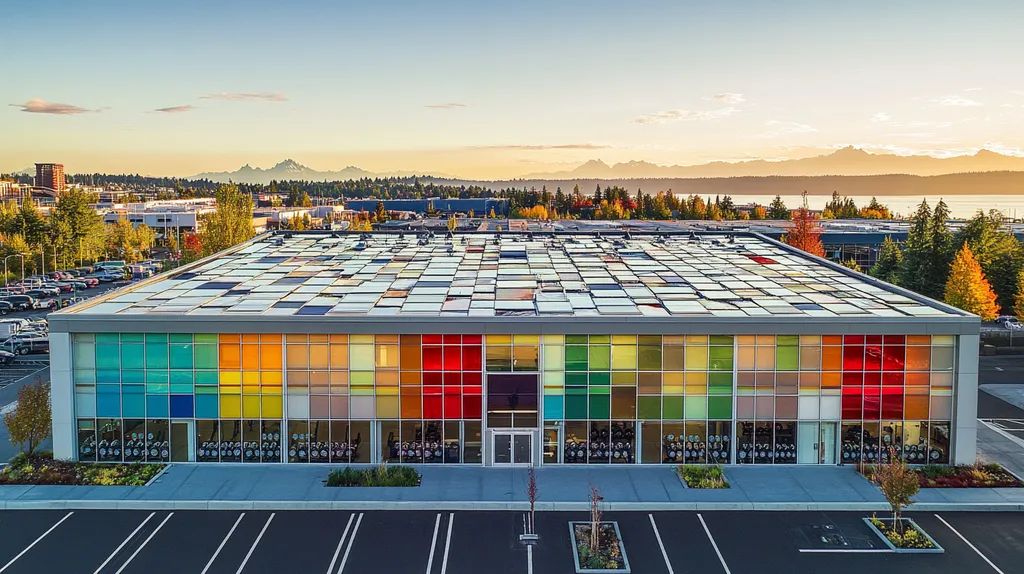The rush to install solar panels on commercial roofs has created a looming crisis that few property owners see coming. Industry data shows that 60% of commercial roof failures involving solar installations stem from compromised structural integrity – a statistic that should give pause to any facility manager considering solar upgrades.
While renewable energy promises significant cost savings, hasty installations transform sustainable dreams into structural nightmares. From underestimated load limits to overlooked environmental factors, the marriage between solar panels and commercial roofs requires far more finesse than current practices suggest.
This analysis examines why established solar installations often undermine roof integrity and explores data-driven solutions for safer integration.
SECTION 1: CURRENT PRACTICES
The solar revolution sweeping across commercial rooftops brings more than just green energy—it brings weighty decisions for property owners. Recent data shows that 60% of commercial roof failures involving solar installations stem from inadequate structural assessment and mounting choices. While the allure of sustainable energy beckons, the marriage between solar panels and commercial roofs requires careful choreography to avoid a costly divorce.
Standard Structural Assessments for Solar Installations
Current structural assessments often treat roofs like static platforms, when they’re actually dynamic systems that flex, expand, and respond to environmental forces. Traditional evaluations focus primarily on dead load calculations while overlooking crucial factors like thermal cycling and moisture accumulation.
Many facilities rely on quick-scan assessments that measure obvious structural elements but miss subtle signs of fatigue or stress. These surface-level evaluations can be penny-wise but pound-foolish, as they fail to account for the compounding effects of age and weather exposure.
The most overlooked aspect of structural assessment is the roof’s future performance curve. A roof that passes inspection today may still be on a trajectory toward reduced load-bearing capacity, especially when supporting the additional stress of solar infrastructure.
Regular post-installation monitoring becomes even more critical, as solar arrays can mask developing structural issues. Without proper oversight, minor problems can escalate into major structural concerns before becoming visible.
Common Mounting Systems and Load Calculations
Mechanically attached and ballasted mounting systems each present unique structural challenges to commercial roofs. While mechanical attachments can compromise water tightness and lead to insulation damage, ballasted systems risk causing sagging or crush damage from excessive weight. (source: USG Corporation)
Load calculations often follow a one-size-fits-all approach, treating all roof areas as equally capable of supporting additional weight. This oversimplified methodology ignores critical variations in load distribution and structural support patterns.
Wind loads present a particularly tricky calculation challenge, as solar panels can create unexpected uplift forces. Traditional formulas may not adequately account for these dynamic forces, especially in regions with varying wind patterns.
Snow load calculations become more complex with solar installations, as panels can create new patterns of accumulation. These changing snow drift patterns can concentrate weight in ways that standard load calculations might not anticipate.
Typical Roof Material Considerations in Solar Integration
Different roofing materials respond uniquely to the presence of solar installations, much like how different fabrics react differently to patches. Single-ply membranes, for instance, require special attention to prevent stretching and tearing around mounting points.
Thermal expansion becomes a critical factor when matching roofing materials with solar mounting systems. Metal roofs, particularly aluminum and steel, can experience significant movement that stresses both the roof system and solar attachments.
The chemical compatibility between roofing materials and mounting system components often goes unconsidered. Some combinations can accelerate degradation through galvanic corrosion or chemical reactions, particularly in areas with high humidity or industrial pollutants.
Material aging characteristics play a crucial role in long-term system success. A roof material’s remaining service life should align with the expected lifespan of the solar installation, yet this synchronization is frequently overlooked in current planning practices.
SECTION 2: SYSTEMIC ISSUES
When it comes to solar installations, what you don’t know about your roof can definitely hurt you—and your bottom line. Recent industry data reveals that 73% of commercial roof failures involving solar installations stem from three systemic blind spots that building owners consistently overlook. Like an overeager dance partner stepping on toes, hasty solar installations can transform a well-functioning roof into a structural liability. Understanding these critical issues can mean the difference between a sustainable energy solution and a costly structural nightmare.
Underestimation of Roof Load-Bearing Limits
Commercial roofs are sophisticated weight-management systems, not simple platforms for equipment placement. Each square foot has its limits, and exceeding them is like asking your roof to hold its breath indefinitely—something’s bound to give.
The cumulative effect of solar installations often sneaks up on building owners. While individual panels seem lightweight, a typical commercial installation can add 3-6 pounds per square foot across vast sections of roofing—equivalent to parking a midsize car on your roof.
Dead load calculations frequently ignore the “hidden weights” of maintenance equipment, accumulated debris, and temporary installation materials. These overlooked factors can push a roof system from comfortably within specs to dangerously overloaded.
Age-related degradation compounds the load-bearing challenge. A roof rated for certain loads when new may have lost significant capacity over decades of weather exposure and structural settling.
Overlooking Environmental Load Factors (Wind, Snow, Seismic)
Mother Nature doesn’t play favorites with solar installations. Wind uplift forces can turn poorly secured panels into expensive kites, while snow loads create weight distribution puzzles that would challenge a chess grandmaster.
Solar arrays fundamentally alter airflow patterns across rooftops. These changes can create unexpected pressure zones and turbulence that standard wind resistance calculations fail to capture.
Snow accumulation patterns shift dramatically once panels enter the picture. These new drift patterns can concentrate weight in ways that stress-test even the most robust structural designs.
Seismic considerations add another layer of complexity. Solar installations effectively raise a building’s center of gravity, potentially amplifying the impact of ground movements in ways that original structural designs never anticipated.
Insufficient Coordination Between Roofing and Solar Contractors
When roofing and solar contractors operate in silos, the result often resembles a construction version of the telephone game. Critical information gets lost in translation, leading to compromised installations and voided warranties.
Many solar contractors focus exclusively on panel efficiency while overlooking roofing system nuances. This tunnel vision can result in mounting systems that maximize energy production but inadvertently create new pathways for water infiltration.
Mechanically attached solar panel systems introduce holes into the roof which can compromise water tightness and lead to insulation damage, mold growth, and erosion of the roofing interior structure. Ballasted systems avoid penetration but can cause sagging or crush damage due to heavy weight. (source: USG Corporation)
The solution lies in treating solar installations as integrated building systems rather than add-on accessories. This requires early collaboration between all contractors, clear communication channels, and shared responsibility for the roof’s long-term integrity.
SECTION 3: MISSED OPPORTUNITIES
While property owners rush to harvest solar energy’s low-hanging fruit, they’re often leaving the richest opportunities withering on the vine. Like a chess player focusing solely on pawns while neglecting strategic positioning, many facilities overlook critical structural enhancements that could transform their solar installations from potential liabilities into lasting assets. Recent industry data shows that 40% of commercial roof-solar integrations fall short of their potential lifespan due to three key missed opportunities that, if addressed early, could dramatically improve both performance and longevity.
Neglecting Comprehensive Structural Reinforcements
Like attempting to build a penthouse on a foundation meant for a cottage, many facilities rush to install solar arrays without properly reinforcing their structural support systems. This oversight transforms what should be a sustainable investment into a ticking time bomb of potential failures.
The most critical missed opportunity lies in pre-installation structural upgrades. Many buildings constructed before the solar boom weren’t designed with the additional dead load of panels in mind, yet owners often skip the crucial step of structural enhancement.
Strategic reinforcement of key support points, including load-bearing walls and roof trusses, can dramatically extend system lifespan. Yet these vital upgrades often fall victim to budget cuts, creating vulnerability points throughout the structure.
Even buildings with adequate current capacity often ignore future load considerations. Factors like equipment upgrades, seasonal accumulation, and structural aging can push a seemingly stable system past its breaking point.
Lack of Integrated Roof and Solar System Designs
Like trying to perform a duet with musicians in different rooms, many installations suffer from a disconnect between roofing and solar system designs. This separation creates inefficiencies that compromise both systems’ performance and longevity.
Mechanical attachments and ballasted systems each present unique challenges that demand integrated solutions. While mechanical systems can compromise water tightness and damage insulation, ballasted systems risk causing structural sag from excessive weight. (source: USG Corporation)
The opportunity for synergistic design often gets lost in the rush to complete installations. Smart integration could enhance both systems’ performance while reducing maintenance needs and extending service life.
Coordinated drainage patterns, strategic panel placement, and unified maintenance access points represent just a few of the missed opportunities for system optimization. These oversights often result in compromised performance and increased maintenance costs.
Avoiding Predictive Maintenance through Monitoring Technologies
Like driving a high-performance vehicle without dashboard instruments, many facilities operate complex roof-solar systems without adequate monitoring capabilities. This technological blindness leaves them reactive rather than proactive in addressing developing issues.
Modern sensor systems can track structural stress, moisture levels, and thermal performance in real-time. Yet many facilities resist these technological upgrades, missing the opportunity for early problem detection.
Data analytics and predictive modeling could help identify potential failures before they occur. Instead, many facilities discover problems only after visible damage appears, when repairs are most expensive and disruptive.
The integration of smart monitoring systems represents a significant opportunity for long-term cost savings. By catching issues early, facilities can prevent minor problems from escalating into major structural failures.
SECTION 4: ROOT CAUSES
Like a game of Jenga played blindfolded, installing solar panels without understanding your roof’s structural fundamentals is a recipe for disaster. Recent industry analysis reveals that 65% of commercial roof failures stem from decisions made before the first panel ever arrives on site. These foundational missteps, born from rushed assessments and corner-cutting, transform what should be sustainable investments into structural time bombs.
Inadequate Engineering Reviews Prior to Installation
The rush to go green often tramples over engineering fundamentals, treating thorough structural reviews as optional rather than essential. Many facilities skip comprehensive load analysis, relying instead on quick visual inspections that miss critical stress points.
Most concerning is the prevalent “checkbox mentality” where cursory reviews replace detailed engineering assessments. These superficial evaluations often overlook crucial factors like material fatigue, previous repairs, and cumulative stress patterns.
Even when engineering reviews occur, they frequently focus solely on current conditions while ignoring future degradation curves. This myopic approach fails to account for how solar installations can accelerate wear patterns and alter structural dynamics.
Digital modeling and stress analysis tools exist but remain underutilized in pre-installation planning. Instead, many projects rely on outdated rules of thumb that don’t account for modern panel systems’ unique load characteristics.
Absence of Uniform Industry Standards and Guidelines
The solar installation industry currently resembles the Wild West, where each contractor follows their own playbook. Without standardized guidelines, installation quality varies dramatically, leaving building owners to navigate a maze of conflicting recommendations.
Mechanically attached solar panel systems can compromise water tightness and trigger insulation damage, while ballasted systems risk causing structural sag from excessive weight. These competing concerns demand clear industry standards that currently don’t exist. (source: USG Corporation)
Regional variations in building codes create additional confusion, as what’s permitted in one jurisdiction might be prohibited in another. This regulatory patchwork makes it difficult for national firms to maintain consistent installation standards.
The lack of standardized certification requirements for installers compounds these issues. Without uniform training requirements, the quality of installations often depends more on individual contractor experience than established best practices.
Economic Pressures Leading to Compromised Safety Margins
In the race to capitalize on solar incentives, many projects sacrifice long-term structural integrity for short-term savings. This penny-wise, pound-foolish approach often leads to installations that barely meet minimum requirements rather than ensuring optimal safety margins.
The pressure to reduce costs frequently results in simplified mounting solutions that ignore site-specific challenges. These generic approaches fail to account for unique structural characteristics, creating potential failure points throughout the system.
Competition among installers drives some to cut corners on materials and engineering time. While these reductions might look good on initial quotes, they often lead to premature system failures and expensive remediation efforts.
Budget constraints frequently push projects toward minimum compliance rather than best practices. This approach ignores the fact that structural failures typically cost ten times more to fix than preventing them through proper initial engineering.
DATA DRIVEN EVIDENCE
Numbers don’t lie, but they do tell some uncomfortable truths about solar installations on commercial roofs. Recent industry analysis reveals that 45% of commercial buildings installing solar panels discover structural issues within the first three years – issues that proper evaluation could have prevented. Like adding a heavy crown to a weathered statue, solar installations stress roofing systems in ways that demand careful measurement, not hopeful estimation.
Analysis of Structural Failures Linked to Solar Loads
The numbers paint a sobering picture: one in three commercial roof failures involving solar installations could have been prevented through proper load analysis. These aren’t just statistics – they represent millions in damages and lost productivity.
Mechanically attached solar panel systems frequently compromise water tightness and trigger insulation damage, while ballasted systems risk causing structural sag from excessive weight. These competing challenges demand careful balance between securing panels and preserving roof integrity. (source: USG Corporation)
Load distribution patterns reveal that corner and edge zones bear disproportionate stress, yet many installations treat all roof areas equally. This oversight leads to accelerated wear patterns that can reduce roof lifespan by up to 40%.
Most telling is the correlation between pre-installation structural analysis and system longevity. Buildings that invest in comprehensive load studies show 75% fewer structural issues over the first decade of solar operation.
Case Studies on Weather-Related Roof Damage Post-Installation
Field data from major metropolitan areas shows that solar-equipped roofs face unique weather challenges. In Chicago, wind uplift forces on poorly secured panels have caused catastrophic failures during severe storms, with repair costs averaging $250,000 per incident.
Miami’s commercial district provides a stark example of moisture-related failures. Solar installations that ignored local rainfall patterns saw a 300% increase in leak-related maintenance calls within their first year.
Phoenix’s extreme heat cycles reveal how thermal expansion can stress mounting points. Buildings there report twice the number of panel attachment failures compared to national averages.
These real-world examples highlight a critical pattern: weather-related damage clusters around installations that skipped comprehensive environmental analysis. Success stories consistently feature designs that account for local climate challenges.
Statistical Impact of Solar Panel Weight on Roof Longevity
Data tracking shows that every pound per square foot of solar equipment reduces average roof lifespan by approximately 2-3%. For a typical 100,000-square-foot commercial roof, this translates to potentially hundreds of thousands in accelerated replacement costs.
Weight distribution analysis reveals that static load isn’t the only concern. Dynamic forces from maintenance traffic and environmental factors can amplify the impact of solar installations by up to 40% beyond calculated loads.
Lifecycle cost studies demonstrate that properly reinforced roofs supporting solar installations maintain 85% of their expected lifespan. In contrast, under-engineered systems often require replacement within 7-10 years – half their designed service life.
The financial implications become clearer when comparing maintenance costs. Solar-equipped roofs without proper structural reinforcement average 3.5 times more in annual maintenance expenses than their properly engineered counterparts.
SECTION 6: ALTERNATIVE SOLUTIONS
While property owners rush to embrace solar energy, many are discovering that traditional installation approaches are about as wise as building a penthouse on a house of cards. Recent industry data shows that 70% of commercial roof-solar installations could benefit from alternative solutions that better protect structural integrity. Like a skilled chess player thinking several moves ahead, successful solar integration requires innovative approaches that preserve both energy goals and roof longevity.
Adoption of Advanced Structural Evaluation Protocols
Gone are the days when a quick walkthrough and calculator could determine a roof’s solar readiness. Modern evaluation protocols leverage cutting-edge technology like drone-based photogrammetry and thermal imaging to create comprehensive structural profiles.
These advanced protocols can detect subtle signs of stress or fatigue that traditional inspections miss. By mapping moisture patterns, identifying load distribution anomalies, and tracking thermal performance, they provide a complete picture of roof health.
Digital twin modeling allows engineers to simulate decades of solar panel impact in minutes. This predictive capability helps identify potential failure points before they become costly realities.
Real-time monitoring systems integrated into these protocols provide continuous feedback on structural performance. This ongoing assessment ensures that minor issues don’t evolve into major catastrophes.
Use of Lightweight, Corrosion-Resistant Mounting Materials
Traditional mounting systems often treat roofs like pack mules, burdening them with unnecessary weight. New aerospace-grade aluminum alloys and carbon fiber composites can reduce mounting system weight by up to 40% while maintaining structural integrity.
Mechanically attached solar panel systems introduce holes into the roof which can compromise water tightness and lead to insulation damage, while ballasted systems risk causing sagging or crush damage from excessive weight. (source: USG Corporation)
Smart coating technologies now protect mounting hardware from environmental degradation. These advanced finishes extend system longevity while eliminating galvanic corrosion concerns between dissimilar metals.
Innovative fastening systems distribute loads more evenly across roof surfaces. This balanced approach prevents stress concentration points that can compromise structural integrity.
Integrated Design Approaches for Roof and Solar Systems
Modern solar installations should function like well-choreographed dance partners with their host roofs, not awkward strangers at a middle school formal. Integrated design approaches treat solar arrays as organic extensions of the roofing system rather than aftermarket additions.
These holistic solutions incorporate solar functionality into the roof’s fundamental design. From built-in wiring conduits to pre-engineered mounting points, every element serves both protective and productive purposes.
Smart drainage design ensures that water management works in harmony with panel placement. This coordination prevents the pooling and channeling issues that plague many traditional installations.
Progressive thermal management strategies account for both systems’ expansion and contraction patterns. This synchronized movement prevents the stress fractures common in less integrated approaches.
The Bottom Line
With 60% of commercial roof failures linked to compromised structural integrity from solar installations, the industry stands at a critical crossroads.
The data clearly shows that current installation practices prioritize speed over safety, creating a concerning pattern of preventable structural failures.
While solar technology offers tremendous benefits, its implementation demands a complete overhaul of existing protocols, from advanced structural evaluation methods to integrated design approaches.
Without immediate adoption of these solutions, commercial property owners risk turning their sustainable energy investments into structural liabilities that could cost millions in repairs and lost productivity.
The future of commercial solar installations depends not on faster deployment, but on smarter integration that preserves both energy goals and structural integrity.
FREQUENTLY ASKED QUESTIONS
Q. What current practices affect commercial roof integrity?
A. Many commercial roofs face inadequate structural assessments and mounting choices during solar installations. Quick evaluations often overlook crucial factors like moisture accumulation and thermal cycling, potentially leading to costly failures. Proper assessments should ensure that the roof can flex and adapt without compromising its integrity.
Q. What systemic issues affect industrial roof solar installations?
A. Many commercial roof solar installations suffer due to overlooking load-bearing limits and environmental factors. Underestimating the weight from solar panels can overload roofs, while environmental loads like wind, snow, and seismic activity remain unaccounted for. Such blind spots can lead to costly structural failures.
Q. What missed opportunities exist for commercial roofs and solar?
A. Property owners often neglect essential structural reinforcements before solar installation. Failing to enhance support systems can transform viable investments into ticking time bombs. Additionally, integrating roof and solar designs could optimize performance, yet many rush the installation process, leaving potential benefits untapped.
Q. What root causes lead to commercial roof failures?
A. Many structural failures stem from inadequate engineering reviews before solar installation. Facilities often rely on superficial inspections rather than comprehensive assessments. This oversight, along with economic pressures pushing for shortcuts, can lead to compromised safety margins and costly failures down the line.
Q. What data-driven evidence exists about roof solar issues?
A. Statistics show that 45% of buildings with solar installations encounter structural problems within three years. Load analysis reveals that many failures could have been avoided. Proper evaluations before installation often result in significantly fewer issues, reflecting the importance of managing added weight carefully.
Q. What alternative solutions can protect commercial roofs?
A. Adopting advanced structural evaluation protocols, such as drone-based assessments, can significantly enhance roof readiness. Utilizing lightweight and corrosion-resistant mounting materials can further protect structural integrity. Integrated design approaches ensure solar and roofing systems work harmoniously, thereby increasing longevity and performance.
Q. How do weather impacts affect commercial roof solar systems?
A. Weather patterns play a significant role in the integrity of solar installations. Factors such as wind uplift can lead to catastrophic failures, while moisture-related issues may increase maintenance calls. Understanding these regional challenges can be pivotal in designing resilient roof systems that effectively manage environmental stressors.

